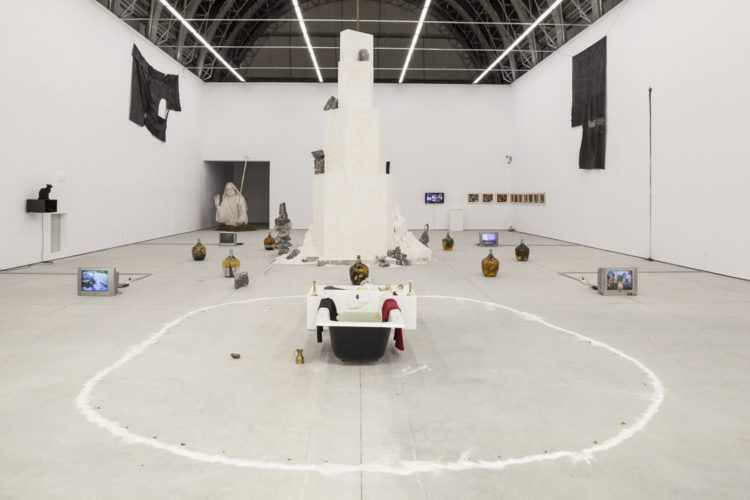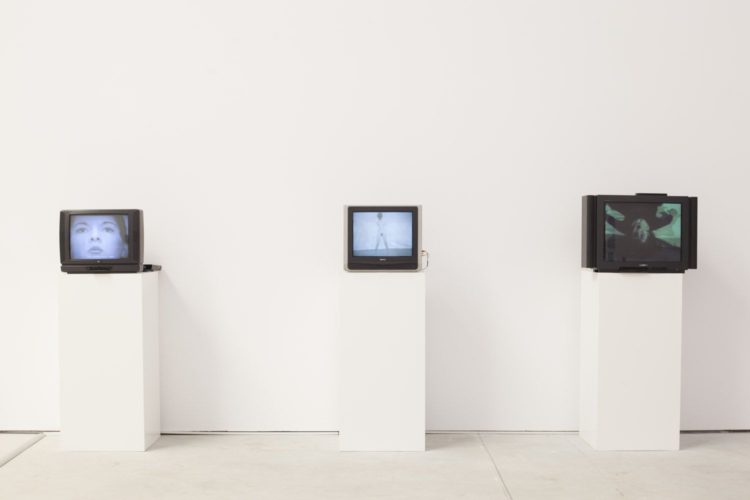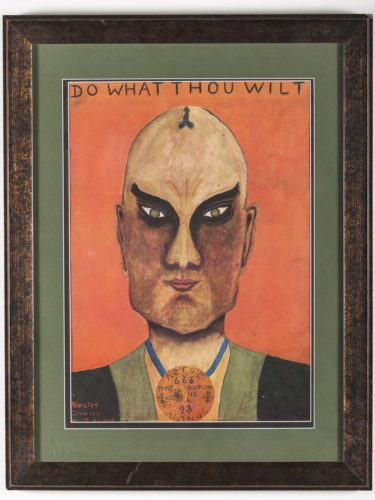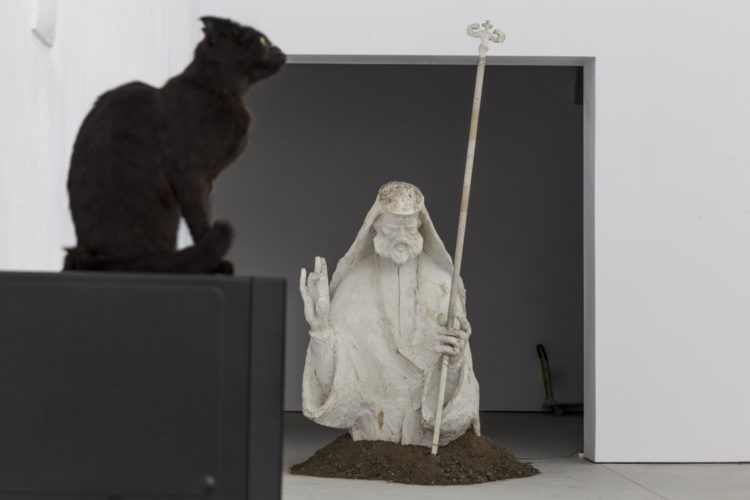Ever since I was a child I had this morbid fascination for all things dark and evil, something that my mother was very bothered about and out to annihilate: it was unbecoming of a girl to indulge in such things. “It’s not a phase, mom!”, and it wasn’t!
When I first entered The Boogeyman exhibition on the 6th of June 2016 my inner goth was jubilating (fueled by the Romanian black metal band Negură Bunget that opened the art show). First thing I saw was the Psychic TV symbol (by artist Breyer P-Orridge) hanging right in the center of the art gallery. “I must be in the right place”, I thought, “Finally, an exhibition that truly explores the occult with its many facets, evil and ancestral fears, mixing artworks from famous artists as well as artefacts by sorcerers, human extinction enthusiasts and serial killers.” (What a strange coincidence – just earlier that day I had come upon some of John Wayne Gacy’s paintings online, only to be looking at the real thing mere hours later).
This was an event unlike any other I’ve seen in Bucharest that year. It was less about artist statements and over-conceptualizing or over-theorizing the boogeyman and more about letting the artworks speak for themselves, it was about connecting to the audience on a more visceral level and getting in touch with one’s fears, nightmares, and traumas. The boogeyman spoke to me because it felt real, palpable, and unpretentious, it was supposed to cater to your soul and it certainly did the trick for mine.
Aaron Moulton, the curator and mastermind of this exhibition, envisioned a trilogy of art events centered around the supernatural, the occult, and the esoteric side of the human psyche, with Bucharest’s Boogeyman being the first. The second, The Basilisk, took place in Los Angeles and the last installment made a full circle and returned to Romania in June 2017 at Nicodim’s newest venue – a recently renovated hangar at Combinatul Fondului Plastic, an industrial complex that is slowly turning into an art hub.
If The Boogeyman brought on darkness and pushed you to face your demons, then The Hierophant was meant to help you re-purpose that energy into something new. The Hierophant, the priest figure of the Rider Waite Tarot’s Major Arcana, represents a guide towards knowledge, insight and wisdom, a holy teacher capable of showing the way. But could this be done properly? The spiritual, the occult, death, and other such sanctimonious themes are pretty hard to pull off; they’re so overdone, it’s easy to fall into a stereotype, not to mention running the risk of appearing tacky.
Lured by the likes of Marina Abramović, Aleister Crowley, Oscar Murillo and the promise of a baptismal performance piece that ties everything together, I had high expectations to see how The Trio Ursitori exhibition series would wrap up. The atmosphere was noticeably lighter than last year’s event – arriving at the scene, I was hit by the smell of barbecue and the sight of sizzling ribs, dinner and a show. The venue was familiar to me, I had had a group exhibition myself in the same building a year before, prior to the renovation, in a state of dereliction and grittiness, and upon entering the newly refurbished hall, now the official HQ of Nicodim Bucharest, I felt as though the spell had been broken – one big white room, the ceiling soaring to dizzying heights, art works scattered all around.
My initial sensation was that of agoraphobia, even thought I was indoors. Compared to the baroque and richly decorated rooms of the old Nicodim gallery, at the prestigious Cantacuziono Palace smack in the middle of Bucharest, this was just another dull white cube, and a huge one at that. Perhaps that was the idea – if the rooms at the old gallery served to create these chambers of shadows where one can immerse oneself and get up close and personal with their worst fears, then the open space and bright lights of new gallery were meant to give a sense of perspective? I felt that the white cube stripped the show of its mystery and aura. Everything was too out in the open, so much so that I couldn’t really take in any of the works.
Just like The Boogeyman, there was no sight of a theoretical art statement other than a letter from Aaron inviting us all to witness and embrace the personal and social changes of the times we live in. The overall theme was that of transformation, of giving and taking, of hybrids and becomings. But the show itself was bland and confusing, to say the least. I wasn’t really sure how to approach any of the artworks, there seemed to be no real connection between any of them, but rather they were overlapping and interrupting each other. A real pity – the works themselves weren’t bad at all: a small statue by sculptor Andrei Marina depicting The Divine Hermaphrodite (Eve emerging from Adam) greets you at the entrance. Next to it was one of Jeremy Shaw’s photo-installations with people from all walks of life experiencing rapture. I particularly liked Christian Jankowski’s Strip the Auctioneer and Yuri Ancarani’s Seance, a very cinematic video interview with deceased architect and artist Carlo Mollino speaking through a medium. These works and others certainly fit the curatorial intention.
Unfortunately most of the exhibition felt like a mediocre sequel to what I personally thought was one of the best art shows I’ve ever experienced, which makes me wonder if The Boogeyman was, in fact, that great or if the sumptuous decorum of the Cantacuzino Palace gave the artworks that mysterious luster that caught my eye. After all, the context can definitely make or break an art show. The Hierophant had all the hype – big catchy names from within and beyond the art world – but it lacked the coherence. If anything, this show was more reminiscent of a group exhibition or a museum exhibit than an art show with a very specific theme. I’m not sure if this was a hit and miss or if the curator just decided to wing it. There are just too many aspects left to chance and this becomes all too evident in the pristine gallery space.
There was an attempt to link at least some of the artworks: salt was the leitmotif of The Hierophant – a huge pillar of salt, which was supposed to dominate the room, just kind of sat there in the middle, surrounded by these glass carboys containing all sorts of objects submerged in oil. These were spells courtesy of occult artist Lazaros arranged in the shape of a Rosetta, I was told. Jorge Peris’ salt Tower of Babel / Stonehenge, commissioned especially for this event, allegedly took a month to build using tons of salt and rocks from the Slănic Prahova salt mine. In front of it sat the bathtub, also surrounded by a trail of salt, where the performance piece was about to take place. Lazaros’ action, along with model Naomi Larbi, was more underwhelming theater than true performance art: Naomi recites your run-of-the-mill ceremonial lines like “I cleanse my skin” and such, she takes a dip in the tub, followed by Lazaros and curator Moulton who violently shivered as they were baptized, just in case anyone had any doubts about the holiness of this endeavor.
Marina Abramović was also present in this exhibition in the form of three tube TVs playing three video-performances which fit the curatorial intention quite well: Freeing the Memory, Freeing the Mind, and Freeing the Body. However, I had hopes for some kind of exclusive pieces, since this was Abramović’s first ever showcase in Romania, not something I can watch on YouTube. It seemed that other artworks had also been selected for their showmanship and how well they fit with the Hierophant theme, like Mihai Istudor’s priest statue which was previously just lying around the Combinat courtyard before it was incorporated in this exhibition. Guess a gallery this size is not easy to fill.
I like to think that this exhibition would have been more successful given the right venue, a little more research and the acquisition of better fitting works, unfortunately the sterility of this particular space exposed this event for what it was – a luxurious cabinet of curiosities that was intriguing, shocking even, but I wouldn’t go as far as to say it was enlightening.
All in all, The Hierophant was less about art and more about show (and a cliché one at that), yet I still enjoyed the beautiful paintings of Simphiwe Ndzube, the amusing photo collages by Jeffrey Vallance and the small Ghenie. Not too bad, but unfortunately it did not rise to the name or transcendence of the archetypal figure of The Prophet/Teacher.
The Hierophant was at Nicodim Gallery between June 17 – July 29, 2017.
POSTED BY
Marina Oprea
Marina Oprea (b.1989) lives and works in Bucharest and is the current editor of the online edition of Revista ARTA. She graduated The National University of Fine Arts in Bucharest, with a background i...
marinaoprea.com


















Comments are closed here.